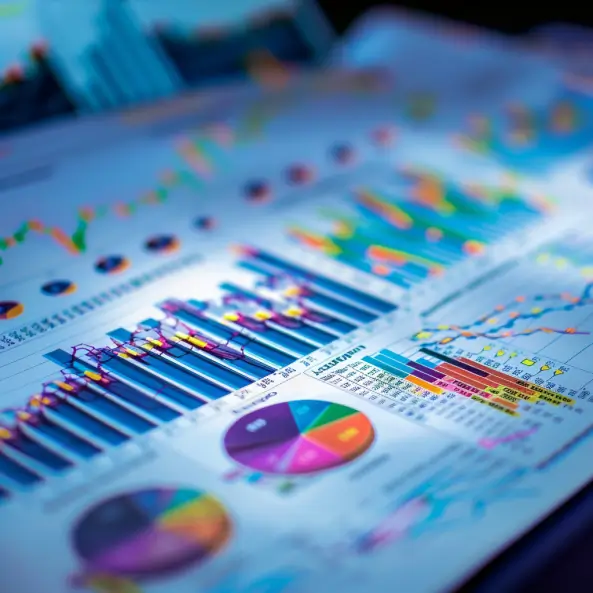Characteristics of a good indicator include being meaningful, relevant, and easy to understand.
A good indicator should also be scientifically well-founded and have a reference or threshold value that signifies its importance.
They should be objective, meaning that if two people measure it, they should get the same result. It’s also crucial for indicators to be timely, providing information in a timeframe that is useful for decision-making.
For a comprehensive understanding of good indicators, they can be said to be ROARS: Relevant, Objective, Adequate (measuring what is supposed to be measured), Reliable (consistent results), and Sensitive (responsive to changes in the condition or phenomenon being measured) (MNE Studies).
In addition to these, indicators should be valid, accurately measuring the behavior, practice, or task that is the expected output or outcome of the program or initiative (End Violence Against Women International).
Lastly, characteristics of a good Key Performance Indicator (KPI) include being attributable, comparable, verifiable, visible, easy to understand and use, cost-effective, and allowing for innovation (DoerHRM).
Indicators are essential tools for measuring progress toward achieving goals and objectives. They provide a way to track performance, identify areas for improvement, and make informed decisions.
However, not all indicators are created equal. Certain characteristics distinguish good indicators from bad ones.

Defining indicators is the first step in understanding their characteristics. Indicators are quantifiable measures used to track progress toward a specific goal or objective.
They can be quantitative or qualitative and are often used to measure outcomes, outputs, or processes.
Good indicators are those that accurately measure progress toward the desired goal or objective and provide meaningful information to decision-makers.
Key Takeaways
- Good indicators are quantifiable measures used to track progress toward a specific goal or objective.
- They should accurately measure progress toward the desired goal or objective and provide meaningful information to decision-makers.
- Criteria for a good indicator include relevance, validity, reliability, sensitivity, and timeliness.
Defining Indicators
Indicators are tools used to measure progress toward a specific goal or objective. They provide a way to assess the effectiveness of interventions, policies, or programs.
Indicators can be qualitative or quantitative, and they can be used to measure outputs, outcomes, or impact.
Types of Indicators
There are two types of indicators: process and outcome indicators. Process indicators measure the activities or outputs of a program or intervention.
They are used to assess whether the program is being implemented as planned. Outcome indicators measure the results or effects of a program or intervention.
They are used to assess whether the program is achieving its intended goals.
Indicator vs. Measure
Indicators and measures are often used interchangeably, but they are not the same thing.
Measures are the tools used to collect data, while indicators are the metrics used to assess progress toward a specific goal or objective.
For example, if the goal is to reduce the number of traffic accidents, the measure might be the number of accidents per 100,000 people, while the indicator would be the percentage change in the number of accidents over time.
Indicators can be qualitative or quantitative. Qualitative indicators are descriptive and subjective. They are used to measure concepts that cannot be easily quantified, such as attitudes or perceptions.
Quantitative indicators are numerical and objective. They are used to measure concepts that can be easily quantified, such as the number of people who have received a particular service.
Indicators measure progress towards goals or objectives. They can be qualitative or quantitative and measure outputs, outcomes, or impact.
Process and outcome indicators are the two types of indicators, and they are used to assess whether a program or intervention is being implemented as planned and whether it is achieving its intended goals.
Measures are the tools used to collect data, while indicators are the metrics used to assess progress.
Criteria for a Good Indicator
Indicators are measurements that help track progress toward a specific goal or objective.
A good indicator should be specific, relevant, objective, measurable, simple, timely, and verifiable. In this section, we will discuss the criteria for a good indicator in more detail.
Relevance
A good indicator should be relevant to the goal or objective it is measuring. It should provide meaningful information about the progress toward achieving that goal.
For example, if the goal is to reduce the number of accidents in a workplace, a relevant indicator would be the number of accidents that occur in a given period.
Measurability
A good indicator should be measurable. It should be possible to collect data on the indicator reliably and consistently.
The data collected should be accurate and reflect the true state of the situation being measured.
For example, if the goal is to improve customer satisfaction, a measurable indicator would be the percentage of customers who rate their satisfaction as “good” or “excellent.”
Simplicity
A good indicator should be simple. It should be easy to understand and communicate to stakeholders.
A simple indicator will help ensure that everyone involved in the project or program can understand the progress that is being made towards the goal.
For example, if the goal is to increase sales, a simple indicator would be the total revenue generated in a given period.
Timeliness
A good indicator should be timely. It should provide information promptly so that appropriate actions can be taken.
Timely information will help ensure that corrective actions can be taken before it is too late.
For example, if the goal is to reduce the number of defects in a product, a timely indicator would be the number of defects found during the production process.
Good indicators are specific, relevant, objective, measurable, simple, timely, and verifiable. They help organizations track progress toward their goals effectively.

Alignment with Objectives
One of the most important characteristics of a good indicator is its alignment with objectives.
Organizations can ensure goal achievement by measuring appropriate indicators. This section will discuss how to align indicators with objectives, specifically strategic goals and business objectives.
Strategic Goals
Strategic goals are the high-level objectives that guide an organization’s vision and strategy.
To ensure that indicators are aligned with strategic goals, organizations should identify the key performance indicators (KPIs) that are most relevant to their vision and strategy. KPIs should be measurable, specific, and time-bound.
For example, if an organization’s strategic goal is to increase customer satisfaction, they might identify KPIs such as customer retention rate, customer feedback score, and net promoter score.
These KPIs will help the organization measure its progress towards achieving its strategic goal.
Business Objectives
Business objectives are the specific objectives that an organization sets to achieve its strategic goals.
To ensure that indicators are aligned with business objectives, organizations should identify the specific metrics that will help them achieve their objectives. These metrics should be measurable, specific, and time-bound.
For example, if an organization’s business objective is to increase sales, they might identify metrics such as conversion rate, average order value, and revenue per customer.
These metrics will help the organization measure its progress towards achieving its business objective.
Aligning indicators with objectives is crucial for organizations to measure progress. By selecting the right KPIs and metrics, organizations can ensure they’re making progress towards their goals.
Quantitative vs. Qualitative Indicators
When it comes to measuring progress, organizations often rely on indicators to assess their success.
There are two main types of indicators: quantitative and qualitative. Each type of indicator has its own strengths and weaknesses.
Number-Based Metrics
Quantitative indicators are number-based metrics that can be easily measured and analyzed. These types of indicators are often used to assess the effectiveness of programs or interventions.
For example, the number of people who have received a vaccination can be easily tracked and measured. Quantitative indicators are also useful for comparing different programs or interventions.
However, quantitative indicators have limitations. They do not provide a complete picture of the impact of a program or intervention.
For example, a program that has a high vaccination rate may not necessarily be effective if the vaccinations are not reaching the most vulnerable populations.
Descriptive Insights
Qualitative indicators, on the other hand, provide descriptive insights into the impact of a program or intervention.
These types of indicators are often gathered through interviews, surveys, or focus groups. Qualitative indicators can provide a better understanding of the context in which a program or intervention is being implemented.
Qualitative indicators can also capture the experiences of those who are directly impacted by a program or intervention.
For example, a qualitative indicator may capture the experience of a patient who has received care from a healthcare provider.
This type of information can help organizations to better understand the impact of their programs or interventions on the people they serve.
However, qualitative indicators also have limitations. They can be difficult to measure and analyze. They also do not provide a complete picture of the impact of a program or intervention.
Both quantitative and qualitative indicators have their own strengths and weaknesses. Organizations should use a combination of both types of indicators to get a complete picture of the impact of their programs or interventions.
Setting Targets and Benchmarks
When setting targets and benchmarks for key performance indicators (KPIs), it is important to define them clearly and measurably.
This ensures that progress can be tracked and evaluated accurately over time.
Key Performance Indicators
Targets should be set for each KPI, and should be specific, measurable, achievable, relevant, and time-bound.
For example, if the KPI is sales revenue, the target might be to increase sales revenue by 10% within the next quarter.
It is also important to consider the context in which the KPI is being measured. For instance, if the company operates in a highly competitive industry, the target may need to be more ambitious in order to keep up with competitors.
Industry Standards
Industry standards can also be used as a benchmark for setting targets. This involves comparing a company’s performance against that of its competitors in the same industry.
Using industry standards as a benchmark, a company can gain a better understanding of where it stands in relation to its competitors.
This can help to identify areas for improvement and set realistic targets that are in line with industry norms.
Overall, setting targets and benchmarks is an important part of measuring performance through KPIs. By defining targets that are specific, measurable, achievable, relevant, and time-bound, and by using industry standards as a benchmark, companies can gain a better understanding of their performance and identify areas for improvement.
Data Availability and Collection
Data availability and collection are critical characteristics of a good indicator. The quality of the data depends on how easily it is available and how it is collected.
Data Collection Systems
Good data collection systems are essential for ensuring data quality. The system should be designed to collect data that is relevant, accurate, and timely.
It should also be user-friendly and easy to use. The system should be able to handle large amounts of data and should be scalable.
One way to ensure that data collection systems are effective is to involve stakeholders in the design process.
This ensures that the system meets the needs of all users and that it is realistic in terms of what can be achieved.
Real-Time Access
Real-time access to data is another important characteristic of a good indicator. Real-time access allows users to access data as soon as it is available.
This enables users to make quick decisions based on the most up-to-date data.
Real-time access to data requires a robust data collection system that can handle large amounts of data. It also requires a system that can process data quickly and efficiently.
Data availability and collection are critical characteristics of a good indicator. Good data collection systems and real-time access to data are essential for ensuring data quality.
Involving stakeholders in the design process and ensuring that the system is realistic, users can access relevant, accurate, and timely data.
Indicator Utility in Decision-Making
Indicators are essential tools for decision-makers, as they provide valuable information that can help improve decision quality.
Good indicators are those that are relevant, objective, and measurable. They should provide information that is useful and can be acted upon.
Informing Future Actions
Good indicators can be used to inform future actions. Decision-makers can use them to identify trends and patterns and to evaluate the effectiveness of past actions.
For example, if an indicator shows that a particular policy has been successful in reducing crime rates, decision-makers can use this information to inform future policies and actions.

Improving Accountability
Indicators can also be used to improve accountability. By providing objective information on the performance of different actors, indicators can help ensure that decision-makers are held accountable for their actions.
For example, if an indicator shows that a particular government agency is not meeting its targets, decision-makers can use this information to hold the agency accountable and take corrective action.
In summary, indicators are essential tools for decision-makers. They can be used to inform future actions and to improve accountability.
Good indicators are those that are relevant, objective, and measurable, and that provide information that is useful and can be acted upon.
Reporting and Communication
Dashboards and Reports
A good indicator should be easy to understand and visible to all stakeholders. Dashboards and reports are great tools for presenting data in an accessible way.
They can be used to track progress, identify trends, and communicate results. Dashboards and reports should be designed with the end user in mind, making sure that the information is presented in a clear and concise way.
When creating dashboards and reports, it is important to consider the audience. Different stakeholders may have different needs and require different levels of detail.
For example, senior management may require high-level summaries, while operational staff may need more detailed information. It is also important to ensure that the data is accurate and up-to-date.
Effective Communication
Effective communication is key to ensuring that the indicator is understood and acted upon.
Communication should be tailored to the audience and should be delivered in a timely and appropriate manner. This may include regular updates, newsletters, or presentations.
It is important to ensure that the communication is two-way. Stakeholders should be allowed to provide feedback and ask questions.
This will help to ensure that the indicator is relevant and meaningful to all stakeholders.
Reporting and communication are essential components of a good indicator. Dashboards and reports can be used to present data in an accessible way, while effective communication is key to ensuring that the indicator is understood and acted upon.
Frequency and Adjustability
Review Cycles
One of the key characteristics of a good indicator is that it is reviewed frequently. This ensures that the indicator remains relevant and aligned with the program’s goals.
Review cycles can vary depending on the program’s needs and the type of indicator being used.
For example, some indicators may require daily or weekly reviews, while others may only need to be reviewed monthly or quarterly.
The frequency of review cycles also depends on the nature of the data being collected. For example, if the data is time-sensitive, such as the number of emergency room visits, then the indicator should be reviewed frequently to ensure that any issues are identified and addressed in a timely manner.
On the other hand, if the data is more stable, such as the number of patients seen in a clinic, then the review cycle may be less frequent.
Adaptable Measures
Another important characteristic of a good indicator is that it is adjustable. This means that the indicator can be modified or adapted as needed to ensure that it remains relevant and aligned with the program’s goals.
The ability to adjust the indicator is particularly important in situations where the program’s goals or priorities change over time.
Adjustable measures are also important for ensuring that the indicator remains “SMART.” SMART stands for Specific, Measurable, Achievable, Relevant, and Time-bound. By adjusting the indicator as needed, the program can ensure that it remains aligned with these SMART criteria.
A good indicator should be reviewed frequently and adjustable to ensure that it remains relevant and aligned with the program’s goals.
By incorporating these characteristics into the planning and implementation of the program, the program can ensure that it is using indicators that are effective and useful for measuring progress and achieving its goals.
Organizational Impact
When it comes to measuring the effectiveness of an organization, indicators are an essential tool.
A good indicator should be able to provide a clear picture of the impact of an organization’s activities. One of the key aspects of a good indicator is its ability to measure the organizational impact.
Employee Engagement
Employee engagement is an essential indicator of organizational impact. Engaged employees are more likely to be productive, innovative, and committed to the organization’s goals.
Managers can measure employee engagement by conducting surveys and analyzing the results. The surveys should focus on areas such as job satisfaction, work environment, and opportunities for growth and development.
By measuring employee engagement, managers can identify areas where improvements are needed and take steps to increase engagement levels.

Customer Satisfaction
Customer satisfaction is another crucial indicator of organizational impact. Satisfied customers are more likely to be loyal and recommend the organization to others.
Managers can measure customer satisfaction by conducting surveys and analyzing the results. The surveys should focus on areas such as product quality, customer service, and overall experience.
By measuring customer satisfaction, managers can identify areas where improvements are needed and take steps to increase customer satisfaction levels.
Measuring the organizational impact of an organization’s activities is essential to its success. Employee engagement and customer satisfaction are two critical indicators that managers should focus on.
Measuring these indicators, managers can identify areas where improvements are needed and take steps to increase engagement and satisfaction levels.

Chris Ekai is a Risk Management expert with over 10 years of experience in the field. He has a Master’s(MSc) degree in Risk Management from University of Portsmouth and is a CPA and Finance professional. He currently works as a Content Manager at Risk Publishing, writing about Enterprise Risk Management, Business Continuity Management and Project Management.

